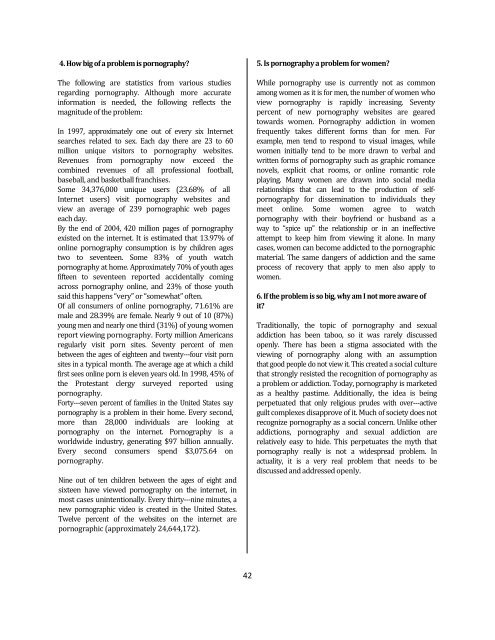Safety Net
Safety Net
Safety Net
Create successful ePaper yourself
Turn your PDF publications into a flip-book with our unique Google optimized e-Paper software.
4. How big of a problem is pornography?<br />
The following are statistics from various studies<br />
regarding pornography. Although more accurate<br />
information is needed, the following reflects the<br />
magnitude of the problem:<br />
In 1997, approximately one out of every six Internet<br />
searches related to sex. Each day there are 23 to 60<br />
million unique visitors to pornography websites.<br />
Revenues from pornography now exceed the<br />
combined revenues of all professional football,<br />
baseball, and basketball franchises.<br />
Some 34,376,000 unique users (23.68% of all<br />
Internet users) visit pornography websites and<br />
view an average of 239 pornographic web pages<br />
each day.<br />
By the end of 2004, 420 million pages of pornography<br />
existed on the internet. It is estimated that 13.97% of<br />
online pornography consumption is by children ages<br />
two to seventeen. Some 83% of youth watch<br />
pornography at home. Approximately 70% of youth ages<br />
fifteen to seventeen reported accidentally coming<br />
across pornography online, and 23% of those youth<br />
said this happens “very” or “somewhat” often.<br />
Of all consumers of online pornography, 71.61% are<br />
male and 28.39% are female. Nearly 9 out of 10 (87%)<br />
young men and nearly one third (31%) of young women<br />
report viewing pornography. Forty million Americans<br />
regularly visit porn sites. Seventy percent of men<br />
between the ages of eighteen and twenty-four visit porn<br />
sites in a typical month. The average age at which a child<br />
first sees online porn is eleven years old. In 1998, 45% of<br />
the Protestant clergy surveyed reported using<br />
pornography.<br />
Forty-seven percent of families in the United States say<br />
pornography is a problem in their home. Every second,<br />
more than 28,000 individuals are looking at<br />
pornography on the internet. Pornography is a<br />
worldwide industry, generating $97 billion annually.<br />
Every second consumers spend $3,075.64 on<br />
pornography.<br />
Nine out of ten children between the ages of eight and<br />
sixteen have viewed pornography on the internet, in<br />
most cases unintentionally. Every thirty-nine minutes, a<br />
new pornographic video is created in the United States.<br />
Twelve percent of the websites on the internet are<br />
pornographic (approximately 24,644,172).<br />
42<br />
5. Is pornography a problem for women?<br />
While pornography use is currently not as common<br />
among women as it is for men, the number of women who<br />
view pornography is rapidly increasing. Seventy<br />
percent of new pornography websites are geared<br />
towards women. Pornography addiction in women<br />
frequently takes different forms than for men. For<br />
example, men tend to respond to visual images, while<br />
women initially tend to be more drawn to verbal and<br />
written forms of pornography such as graphic romance<br />
novels, explicit chat rooms, or online romantic role<br />
playing. Many women are drawn into social media<br />
relationships that can lead to the production of selfpornography<br />
for dissemination to individuals they<br />
meet online. Some women agree to watch<br />
pornography with their boyfriend or husband as a<br />
way to “spice up” the relationship or in an ineffective<br />
attempt to keep him from viewing it alone. In many<br />
cases, women can become addicted to the pornographic<br />
material. The same dangers of addiction and the same<br />
process of recovery that apply to men also apply to<br />
women.<br />
6. If the problem is so big, why am I not more aware of<br />
it?<br />
Traditionally, the topic of pornography and sexual<br />
addiction has been taboo, so it was rarely discussed<br />
openly. There has been a stigma associated with the<br />
viewing of pornography along with an assumption<br />
that good people do not view it. This created a social culture<br />
that strongly resisted the recognition of pornography as<br />
a problem or addiction. Today, pornography is marketed<br />
as a healthy pastime. Additionally, the idea is being<br />
perpetuated that only religious prudes with over-active<br />
guilt complexes disapprove of it. Much of society does not<br />
recognize pornography as a social concern. Unlike other<br />
addictions, pornography and sexual addiction are<br />
relatively easy to hide. This perpetuates the myth that<br />
pornography really is not a widespread problem. In<br />
actuality, it is a very real problem that needs to be<br />
discussed and addressed openly.


